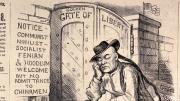We are all “medical citizens,” embedded as potential or actual patients, with physicians, in a system of social, moral, and organizational understandings. So writes Monrad professor of the social sciences Charles E. Rosenberg in Our Present Complaint: American Medicine, Then and Now (Johns Hopkins, $50; $19.95 paper), touching on sources of unease.
Disease has become a bureaucratic—and, thus, social and administrative—as well as biological and conceptual—entity.
What do I mean when I describe disease as a “social entity”? I refer to a web of practice guidelines, disease protocols, laboratory and imaging results, meta-analyses, and consensus conferences. These practices and procedures have over time come to constitute a seemingly objective and inescapable framework of disease categories, a framework that increasingly specifies diagnostic criteria and dictates appropriate therapeutic choices. In America’s peculiar hybrid health-care system, layers of hospital and managed care administrators enforce these disease-based guidelines. The past generation’s revolution in information technology has only exacerbated and intensified these trends—in parallel with the research and marketing strategies of major pharmaceutical companies…. This web of complex relationships has created a new reality for practitioners and patients alike. Physicians have had their choices increasingly constrained—if, in some ways, enhanced. For the sick, such ways of conceptualizing and treating disease have come to constitute a tangible aspect of their illness experience.
Of course, every society has entertained ideas about disease and its treatment; patients have never been blank slates.…Think of the generations of sufferers who were bled, sweated, puked, or purged to balance their humors. But never has the infrastructure of ideas, practices, thresholds, and protocols that comes between agreed-upon knowledge and the individual patient been so tightly woven and bureaucratically crafted.…
Yet, as I have emphasized, we are left with that inconveniently subjective object, the patient—in whose body these abstract entities manifest themselves. This is the characteristic split screen that faces today’s clinician: the tension between illness in the individual patient and disease as crystallized and made socially real in the laboratory’s and the epidemiologist’s outputs and inscriptions, practice guidelines, and algorithms.…Bedside, clinic, and physician’s office are the points at which the mandates of best—and increasingly most economically rational—practice bump up against the unique reality of the individual patient and challenge the physician’s traditional autonomy.…
It engenders a feeling of paradox, the juxtaposition of a powerful faith in scientific medicine with a widespread discontent at the circumstances in which it is made available. It is a set of attitudes and expectations postmodern as well as quintessentially modern.







